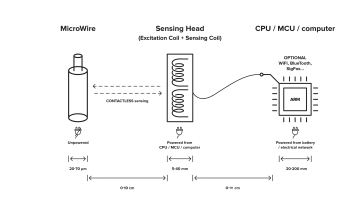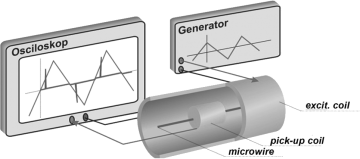Technical overview of MicroWire sensing system
Our sensing solution consists of 3 important parts.
Sensor – MicroWire
MicroWire sensors by RVmagnetics are miniaturized (diameter ca. 3–70 µm) magnetic contactless sensors of various physical quantities (temperature, pressure, torsion, magnetic field, position, and more – see section Discover Applications ). MicroWires are made of metallic core (diameter ca. 1 – 50 µm) and glass coating (thickness 2 – 20 µm). Thanks to their exceptional properties such as size, simple production process, glass-coating, contactless sensing (passive), it creates the opportunity for their utilisation as a miniaturised sensor with a wide range of applications in different industries: IoT, Industry 4.0, Structural Health Monitoring, Automotive, Aerospace, Smart materials, Healthcare, Anticounterfeiting and many other areas. One of the main advantages of the MicroWire sensor lies in the possibility of incorporation into the materials (without creating defects).
Sensing system – coils, microprocessor, electronics
MicroWire sensors are magnetic. To sense them, we need to generate an AC magnetic field (triangual or other) with excitation coil. Unless present in noisy magnetic or electric fields, coil is powered with a few milliAmperes. The magnetic response from the MicroWires (with high sensitivity to temperature, pressure and position in the magnetic field ), in terms of a magnetization change, is sensed with another pick up/sensing coil.
Output from the sensing coil includes signals from magnetic and electric noises present in the vicinity of the sensing coil during the measurements. Signal obtained needs to be filtered out of noises and also amplified.*
Filtered and amplified signal is digitalised in MCU (ARM chip) and ready for data post-processing in customer's preferred software.
* The signal can be obtained from a maximum distance up to 10cm.

We use ARM customized chip as a processing system. Coils are directly connected to the electronics, while electronics digitalize the received data, and through USB, or using Bluetooth / Wi-Fi / SigFox, … It can send the digitalised data where you need them for further processing.

MCU – Data Processing
The filtered and amplified signal obtained by the sensing coil is digitalized in an MCU (ARM chip) and is ready for data post-processing using the customer's preferred software. RVmagnetics uses an ARM-customised chip as a processing system, which covers a significant part of the whole technical solution's power consumption. The data processing system (MCU) can be placed even several meters from the data acquisition system (sensing head). Digitalised data might be sent via USB cable, wireless methods, such as Bluetooth, WiFi, or SigFox, or sent directly to the cloud. Received data output from the ARM chip is further processed and calibrated using RVmagnetics' tailor-made software.
Summary
MicroWire, as a local sensor of different physical quantities, provides an exceptional combination of properties, such as micro-dimensions, passive character, the ability to be incorporated inside the materials, contactless sensing, and others. Sensing the information from the MicroWire can be performed from a distance of up to 10 cm, even through the materials (even metallic and magnetic ones)., employing a set of coils (excitation and sensing coil). These are wired to distant electronics containing an ARM chip, which digitizes the obtained signal. Data might be sent via cable or wirelessly to another entity (computer) to be processed, saved, and evaluated.